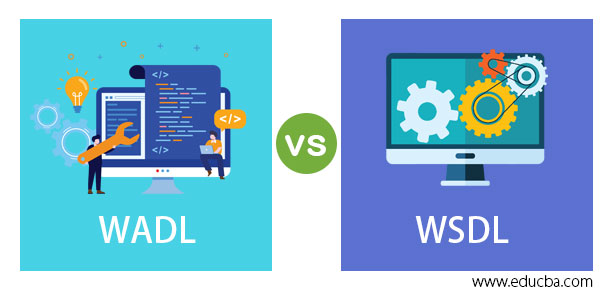Updated March 28, 2023

Difference Between WADL vs WSDL
In this article, we are about to discuss on WADL vs WSDL. Previously we studied SOAP vs REST. WADL vs WSDL is to look through the key differences and compare them. With RESTful Web services’ rise, there becomes a necessity to introduce contracts/ interfaces for these types of web services. WADL and WSDL are web service contracts/ interfaces between client and server. One of the important parts of a web service is the interface that lies between the server and the client.
Head to Head Comparison between WADL vs WSDL (Infographics)
Below are the top 15 comparisons between WADL vs WSDL:
Key differences between WADL vs WSDL
Let us discuss some key differences between WADL ( Web Service Description Language ) vs WSDL ( Web Application Description Language ) in the following points:
1. WADL is an XML file-format, whereas WSDL is an XML language for describing web services.
2. WADL is a machine-readable description of HTTP based REST web services.
3. Web service is described as a set of communication endpoints/ ports; endpoints are made of operations and messages
4. WSDL works in providing operations/ messages and the data needed to invoke
5. Interfaces are accessed using data formats and protocols, located as a specific network address such as URL.
6. WADL is used to simplify web service reuse based on existing HTTP architecture, described using a set of resource elements.
7. For RESTful and hybrid services, Web Application Description Language is preferred, WADL library parses files and possible service requests as API.
8. Major elements of WSDL:
| Element | Description |
| <types> | Defines data type used in the XML schema web service. |
| <message> | Defines data elements for each operation in web service. |
| <portType> | Operations and messages involved in a web service are described. |
| <binding> | Defines protocol and data format based on port type in a web service. |
9. Major elements of WADL:
| Element | Description |
| <grammars> | Specify W3C XML Schema in web service. |
| <resources> | Specifies methods being supported for web service as a URI template. |
| <methods> | Specifies request and response details for a web service. |
| <representation> | Describes the HTTP format, which refers to grammar. |
10. WADL is described as a set of resource elements consisting of inputs and element methods that describe request and response.
Comparison Table of WADL vs WSDL
The table below summarizes the comparisons between WADL vs WSDL:
| WADL | WSDL |
| Web Application Description Language. | Web Service Description Language. |
| XML to describe RESTful web services. | XML to describe SOAP-based web services. |
| A client can load a WADL file and can access the complete functionality of the web service. | A client can load a WSDL file and know what methods web service can call, what arguments the methods expect, and which data type it returns. |
| WADL is the REST equivalent of SOAP’s web service description language. | Machine-readable description with the current version of 2.0. |
| WADL is lightweight, easy to understand and write. | Compared to WADL, WSDL is difficult to write and understand. |
| It does not have binding to SMTP servers. | It has more binding to SMTP servers. |
| Simple by Design. | Complex by design. |
| There is no Authentication involved in web services. | Authentication is involved in web services. |
| It requires a simple URI Template mechanism. | The user needs to define the XML input message to use the URI Template mechanism. |
| It has a Limited Scope compared to WSDL. | It has more scope compared to WADL. |
| W3C does not recommend the WADL interface. | W3C recommends a WSDL interface. |
| WADL strictly supports REST Service, only HTTP protocols. | WSDL 1.1 only supports GET and POST methods, whereas WSDL 2.0 supports HTTP protocols also. |
| WADL covers all user expectations except Authentication, which is as simple as REST. | WSDL is more flexible than WADL. |
| WADL defines both resources and representation and methods to manipulate resources. | WSDL defines all major elements which may be defined 0 or more times except <types>. All definitions need not be in the same XML; one XML can import others.
Hence comes the concept of Abstract and Concrete portions, where concrete imports abstract. |
| WADL representation consists of two functions for the POST method and one for the GET method; a set of XSD files is attached to this method to describe XML representation of input and output objects and generate WADL format of REST service URI’s can be used. | WSDL is automatically generated using? WSDL and service URL, then adding the web service URL as web reference in the project, generates clients/ stubs from you. In java, tools like wsdltojava to generate a client. |
Conclusion
WSDL 2.0 defines an explicit mapping of HTTP protocols along with GET, POST, PUT and DELETE methods. WSDL is resource-oriented and not service-oriented; hence RESTful services compared to WADL differ.Abstract elements are <types>, <message>, and <portType>/ <interface> in WSDL 2.0. Concrete elements are <binding> and <service>. This separation allows for maximum reuse and flexibility in defining WSDL services. This has certainly been an excellent tour of WADL vs WSDL. We have covered key points and differences of WADL with WSDL in a fair manner; we have also seen interfaces of WADL, WSDL 1.1 and WSDL 2.0., but there is a lot to explore these service specifications.
Recommended Articles
This is a guide to the top differences between WADL vs WSDL. Here we discuss the WADL vs WSDL key differences with infographics and comparison table. You may also have a look at the following articles to learn more –

